Strategies
for Visual Storytelling
This article will demonstrate the use of researched
imagery in communicating interactive stories. It uses the storyboard
of the Studio Project One article.
From my visual research, I have a 1948 world fair
futuristic interior that is shaped like a circle, and thus shares
the heritage of Buckminster Fuller's geodesic domes--as well
as the architecture of Epcot Center and of previous World Fairs.
I also have an image of a 1895 world's fair exhibit of MIT. The
first aesthetic strategy that I am using here is the use of interior
images for exterior architectural structures. These source images
form a regular rectangular building structure and cap it with
a globe.
The globe references the architecture of the future
through the lens of the past. As recent architecture is informed
by computing issues, I use a computational cube done in Illustrator
(vector graphics) as the architecture of the future, as we speculate
on the future now that the future of the past has passed.
What this interior/exterior flipping does, among
other things is to let me establish the theme of this imaginary
world's fair, the role of the fair in taking an historical point
of view while focusing on the notion of form and structure--anything
from advanced plastics to new architecture.
This theme is a framework for the the use of other
historical views taken in the use of the enigma machine for musical
compositions at the end of the story, to reduce existing racial
tensions 55 years after the war--if they do indeed exist. Because
the story involves several historical events, it is good to establish
this theme early on.
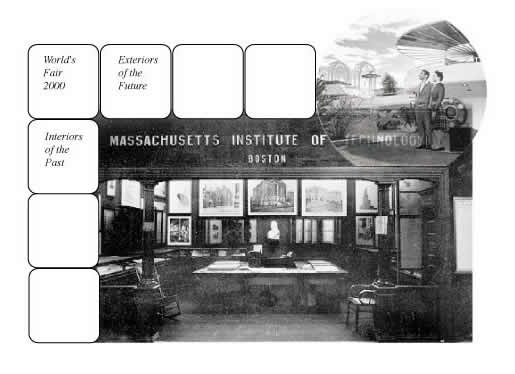
Now as the narrative progresses, we reveal that
IBM and AT&T are presenters at this worlds fair. To tell
this story and represent it, I chose to make the following image,
where the computing companies form exterior structures that were
previously formed by the interior structures.
A relationship is established as one of futuristic
architecture. Futuristic architecture is operative in the IBM/AT&T
image, as well as the opening page's image. What is the content?
In the first, it identifies the worlds fair with actual spaces
for exhibits; in the second it merely repeats the structure of
the first, and also indicates that these two companies might
be players in the exhibit displays.
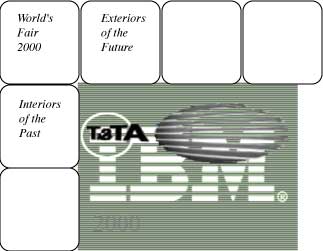
The next step is to indicate the
mystery presenter, or unknown presenter. If we show the above
image again, and place a rollover in the box, third from the
left we can do this within the conventions of web pages, while
adding interactivity.

To position the rollover, I used DHTML or Dynamic
HTML. How to do this procedure.
Move the mouse over the third box from the left
on the top row of rounded squares. You should see a silhouette
with a question mark. You will notice the hand icon appearing
in the cursor which indicates that the rollover can also be a
link. You may link to the page via the rollover.
Finally, we need an image of a keynote speaker
meeting the unknown speaker, or the storytelling montage of the
event:
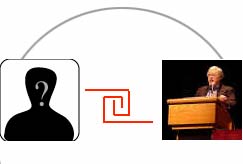
The globe of the architecture of world's fairs
is used to link the two speakers and a symbolic handshake graphic
is put between them also. The half globe suggests a common interior
for the event and the red hand clasp suggest a connection of
sorts.
The benefits of research:
Sometimes source material directly leads to image creation and
innovation. Take for example this image of the enigma machine
with a square note in its cover. this can easily be replaced
with a screen for notes etc.
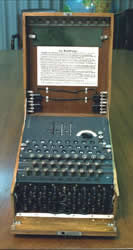 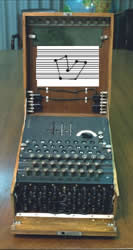
|

